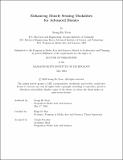Enhancing Muscle Sensing Modalities for Advanced Bionics
Author(s)
Yeon, Seong Ho
DownloadThesis PDF (30.23Mb)
Advisor
Herr, Hugh M.
Terms of use
Metadata
Show full item recordAbstract
Muscle sensing technologies have significantly advanced our understanding of biomechanics and enhanced the efficacy of bionic devices. These technologies enable volitional control of prostheses and assistive devices by mapping the electrical and mechanical activities of muscles as control inputs. This dissertation presents novel paradigms and findings to improve the utility and efficacy of muscle sensing modalities for advanced bionic applications.
In the first part, I introduce a comprehensive approach to improve the acquisition and processing of surface electromyography (sEMG) signals for bionic applications. This includes innovations in electrode materials and design to enhance user comfort and signal quality for long-term use within prosthetic sockets. Additionally, I propose a real-time impulse filtering algorithm to effectively suppress artifacts while preserving the underlying sEMG signal during dynamic movements. Furthermore, I demonstrate a synchronous sEMG and ultrasound acquisition method that enables simultaneous assessment of muscle electrical activity and mechanical deformation, providing valuable insights into muscle function and control.
In the second part, I explore how Magnetomicrometry can serve as a new in-vivo and real-time mechanical muscle state tracking modality. Previous work has shown significant potential for Magnetomicrometry in muscle-state tracking via a tightly-controlled in situ setup. In this work, I demonstrate real-time tracking of muscle tissue length in freely-moving animals performing various motor activities, suggesting that Magnetomicrometry could be extended as a viable in-vivo and real-time muscle sensing modality.
In the final part, I propose a novel theoretical framework leveraging Riemannian geometry and manifold theory to enhance the magnet tracking technology stack for Magnetomicrometry. By representing the magnetic dipole state on a manifold and incorporating its dynamics, I develop a more accurate and robust magnet tracking algorithm that addresses the limitations of existing methods. Through simulations and real-world data evaluations, I demonstrate the superior performance of the proposed manifold-based tracking paradigm, showcasing its potential to improve the resolution and extend the observable depth of Magnetomicrometry.
The advancements presented in this dissertation have significant implications for the development of next-generation bionic devices, enabling more adaptive, versatile, and reliable myo-neural interfaces. Through this work, I hope to open up new possibilities for the design and control of advanced prostheses and assistive technologies with the advanced myo-neural control interface.
Date issued
2024-05Department
Program in Media Arts and Sciences (Massachusetts Institute of Technology)Publisher
Massachusetts Institute of Technology